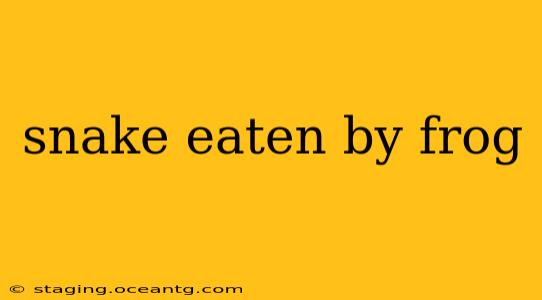The image of a frog consuming a snake is undeniably striking. It completely flips the typical predator-prey dynamic we're accustomed to seeing in nature. While not a common occurrence, it's certainly possible, and understanding the circumstances under which it happens reveals fascinating insights into the intricate web of life in the wild. This article will delve into the rare phenomenon of frogs eating snakes, exploring the species involved, the mechanics of the predation, and the factors that might make such an event possible.
What Kind of Frogs Eat Snakes?
The ability of a frog to eat a snake is largely dependent on the size and species of both the frog and the snake. Larger frog species, possessing strong jaws and a robust digestive system, are more likely to successfully prey on smaller snakes. Some examples of frog species capable of such a feat (depending on the size of the snake) include:
- Bullfrogs ( Lithobates catesbeianus): Known for their substantial size and aggressive nature, bullfrogs are capable of consuming a surprisingly large range of prey, including small snakes.
- Giant Goliath Frogs (Conraua goliath): As the world's largest frog species, the Goliath frog's impressive size and strength make it a potential predator of small snakes. However, documented instances of this are incredibly rare.
- Other large frog species: Various other large frog species found in tropical and subtropical regions could potentially consume small snakes under the right circumstances.
How Does a Frog Eat a Snake?
The process of a frog eating a snake is not a quick or graceful one. It involves a powerful grip from the frog's strong jaws and often a considerable struggle. The frog typically begins by seizing the snake's head or body with its powerful jaws. The snake will likely fight back, but the frog's strength and grip often prove too much. The frog then proceeds to swallow the snake whole, a process that can take considerable time and effort, often involving much pushing and pulling.
What Size Snake Can a Frog Eat?
The size of the snake a frog can successfully consume is directly proportional to the size of the frog itself. A large bullfrog might be able to manage a relatively small, slender snake, perhaps no longer than a few inches. Larger frogs might tackle slightly larger prey, but the size difference is crucial. A snake significantly larger than the frog would likely be too much to handle.
What are the Circumstances Under Which This Happens?
Several factors contribute to the rare instances of frogs eating snakes:
- Opportunistic Predation: Often, the frog may encounter a weakened, injured, or young snake, making it an easier target.
- Ambush Predation: Frogs are ambush predators, relying on surprise attacks. A snake caught off guard in a frog's territory might become prey.
- Specific Environmental Factors: The availability of alternative prey sources plays a role. If other food sources are scarce, a frog may be more likely to attempt to consume a snake.
Are There Videos or Pictures of This Happening?
While sightings of frogs eating snakes are infrequent, you can find anecdotal accounts and photographic/video evidence online. Searching for "frog eating snake" on platforms like YouTube or image search engines may yield some results. Remember, the validity of online sources should always be carefully evaluated.
Conclusion
The sight of a frog devouring a snake is undoubtedly unusual and captivating. It serves as a reminder of the complex and often unexpected interactions within ecological systems. While not a regularly observed phenomenon, it highlights the adaptability and opportunistic nature of certain frog species and emphasizes the dynamic relationship between predator and prey in the wild. The size of both the frog and the snake is the determining factor in the success of such a predation event.
